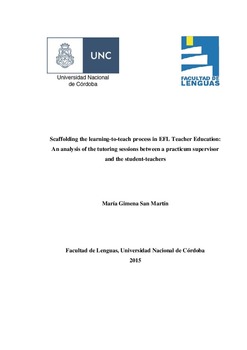| dc.description.abstract | Guiding and supporting students has always been a key feature of a teacher’s role. Helping learners to go through their evolving zones of proximal development, and gradually, develop more complex developmental levels requires teachers to carefully and gradually scaffold their students’ learning. Scaffolding has been defined as an interactive dialogic construct in which all the participants involved play a crucial role. However, the literature reveals that most research in scaffolding has focused considerable attention on the multiplicity of types of assistance and/or support that teachers can provide. The distinct features of scaffolding are still not completely understood. From the perspective of Socio-cultural Theory (SCT), the purpose of this research study is to examine how a supervisor scaffolds the student-teachers’ learning-to-teach process in the context of one-to-one tutoring sessions in an EFL Teacher Education programme in Córdoba, Argentina. The audio-recordings of the tutoring sessions were transcribed verbatim and both macro and micro-level analyses were carried out. Two main frameworks – the Model of Contingent Teaching (MCT) and the Contingent Shift Framework (CSF) – were employed to first describe how scaffolding unfolds in the context of the research and then measure whether and to what extent scaffolding occurs in the one-to-one tutoring sessions. The findings indicate that scaffolding implies two main phases or stages: a diagnostic and an intervention phase. In the former, the supervisor was found to elicit considerable information from the student-teachers and challenge them the most whereas in the latter, she offered help mainly by means of feedback, explaining and instructing and challenged them the least. In addition, about 50% of the interactions analyzed were found to be contingent, and thus scaffolding instances since she adapted her degree of control to the student-teachers’ level of understanding. Although links can be established between the strategies deployed by the supervisor and supervisory roles and skills, the ways in which the supervisor’s scaffolded help is realized should be understood in relation to the function it serves and how it accommodates the student-teachers’ level of understanding in order to accurately depict the scaffolding process. | es |





